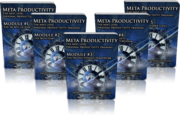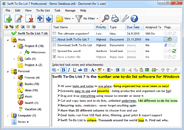Are you genius at wasting time, fooling both yourself and others?
The common sense is that you are either procrastinating, or you are not. And if you are procrastinating, you always know it.
Well, I don’t agree with these statements.
There are multiple levels of procrastination.
But I plead you to stop reading this if you know that you are currently procrastinating. Do yourself a favor and go fix your procrastination issue first. You are lucky because your procrastination is NOT hidden. You can absolutely fix it. You can start by reading my detailed summary of The Now Habit, which is one of the best books on procrastination. Spending more time on proactive tasks instead of reactive tasks also helps. Fooling yourself into working works, too.
OK, with half the audience still remaining, let’s get back to the original question: Are you a genius at wasting time?
You probably had the experience of joyously cleaning/polishing/organizing stuff instead of doing THAT important task. That is the regular garden variety of procrastination. But what I am going to suggest here is that there are multiple levels of procrastination.
Sometimes it might feel like you are working and being productive, but the reality might be that you are, in fact, procrastinating – and you don’t even know it!
It works like this -
| If you should do: |
But instead do: |
Then it is: |
| Important task |
Less important task |
Hidden procrastination |
| Important task |
Unimportant task |
Procrastination |
| Unproductive task |
Something even more useless |
Wrong planning, buddy. |
“Hidden procrastination” is wasting time in an elaborate way. It might be actually productive (albeit less productive than THAT task), or it might be just pseudo-productivity.
You might object: “HEY! If I am working on something important, then I can’t be possibly procrastinating!” Good point sir, thanks for bringing that up! Well, you might be working on something that actually is important – but if there is something else that you know to be more important, then it can be helpful for you to think of what you are doing as procrastination. Why? Because you can use the same approach to fix your “prioritizing” issue as you would use to fix a blatant case of procrastination. E.g. you can apply the techniques from The Now Habit book.
Detecting hidden procrastination
Sometimes, you just need to take one step back and ask yourself:
Is this the most important thing I could be doing right now?.
And:
What am I missing here, in the grand scheme of things?
Sometimes, these questions will help you discover where you stand, and sometimes, they will make you drop what you are currently doing and make a quantum leap to an entirely different level. If you spend most of your time zoomed in, you need to zoom out from time to time – just to make sure what you are doing still makes sense.
That’s it. This is the most important thing I wanted to tell you.
More on pseudo-productivity
In case of pseudo-productivity, you might absolutely convinced that you are doing something important, and you might very well convince others as well, but it might be entirely irrelevant a month from now.
The signs that you are possibly pseudo-productive include:
- You are not working on the 1st, 2nd or 3rd most important thing.
- What you are doing now won’t matter 1 year from now (And if it won’t matter 1 month from now on, I think you should reconsider your long-term strategy!)
- You should’ve already moved to the next task, others would confirm that when asked.
- You are obviously over-delivering with only an abysmal chance of payoff.
- You are over-worked, tired, or daydreaming a lot.
- You are having trouble staying focused.
- Excessive organizing or planning.
- You are eternally grateful for any external stimuli or distraction that prompts you to do something else, and you’ve mastered rationalizing how it might be useful or important.
Oh, and if your environment forces you to spend more time on bureaucratic tasks than real tasks, then the whole environment has systemic problems. Change the environment – either transform it or leave. You can’t possibly be happy in such a place.
Traps of complex organizing tools
Pseudo-productivity is often related to over-organizing, over-planning, and thus, your task management software. Such tools can be so complex that you fiddle with it all the time instead of doing the actual work.
The sole purpose of your organizer is to allow you:
- Always know what to do next
- Capture everything – tasks, ideas, notes (task details), knowledge snippets, and maybe even related documents and emails
- Delegate and monitor tasks – even if you are not a manager, you will be responsible for tasks that require work of someone else, and you need to stay on top of such delegated assignments.
- Do some basic planning
Everything else is just more or less a waste of time. You don’t need super detailed plans that include toilet breaks.
The purpose of always knowing what to do next is to ensure that you are working on the most important thing, and that your work is friction-less and focused.
The purpose of capturing is that it frees your mental RAM. You take it out of your head, and put it into the organizer. Then keep working on THAT thing.
My experience is that my organizing needs vary a lot in time. Sometimes, a single sticky note might be enough to keep me organized for a day, and sometimes I really need to overview hundreds of to-do items and write notes for some of them.
In case you didn’t know, I’m the author of Swift To-Do List, a task/notes organizer for Windows.
Perhaps you don’t even use Windows – but let me quickly tell you about some of the things that I think are important in task management software in general, and that I’ve implemented into Swift To-Do List. It might help you find the perfect tool for you.
When it comes to prioritizing, you can just drag and drop tasks around, or sort them by multiple columns at once (First by Due Date, then by Priority). Color codes for priorities help me to highlight THAT important tasks.
Capturing is also thought-of in Swift To-Do List. Not only you can write rich-text notes for each task, but you can create task-independent notes and organize them in the hierarchical tree along with to-do lists. Having that integrated with task-management is invaluable for me. Also, you can attach files and emails to tasks, and even embed the files directly into the database. A killer feature is ability to drag & drop emails from email clients (such as Thunderbird, Outlook, Lotus Notes, The Bat) into Swift To-Do List to instantly generate tasks from them, complete with the attachments.
Delegating is handled simply using the Assigned To field, plus the ability to email the task directly to the assignee right from the program.
When designing Swift To-Do List, I’ve put into tremendous effort into customization and flexibility. When I don’t need some features, it is very important for me to be able to hide them. In Swift To-Do List, the whole GUI changes based on what columns you use (Start Date, Due Date, Priority, Context, Type, Assigned To, Time Estimate, Time Spent, etc.) This keeps things simple.
Wrapping this up or TL;DR
1) When you are not working on your most important tasks, it is helpful to think of it as procrastination. It allows you to correct the problem by utilizing the existing infrastructure of procrastination solutions (books, techniques, tools, experts).
2) Sometimes, you just need to take one step back and ask yourself:
Is this the most important thing I could be doing right now?.
And:
What am I missing here, in the grand scheme of things?
3) Make sure your organizer is actually helping you to prioritize, capture everything, and stay on top of things.
Related Posts:






